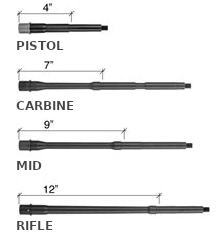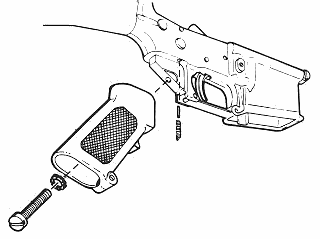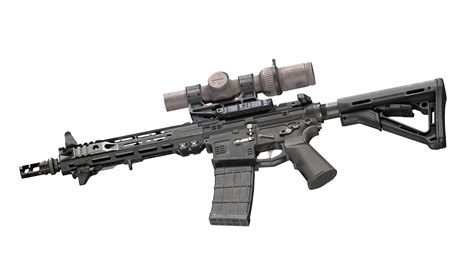Difference between revisions of "AR-15 Carbine Rifle"
m |
m (→miscellaneous) |
||
| Line 39: | Line 39: | ||
== miscellaneous == | == miscellaneous == | ||
Other customization options include your choice of 1) Optics, 2) Flash suppressor, 3) Custom trigger, 4) Bolt Carrier Groups, 5) Extended Charging Handle, 6) Buffer System, and 7) lazers, lights, 8) custom finish. | Other customization options include your choice of 1) Optics, 2) Flash suppressor, 3) Custom trigger, 4) Bolt Carrier Groups, 5) Extended Charging Handle, 6) Buffer System, and 7) lazers, lights, 8) custom finish. | ||
| + | |||
| + | Example of a highly customized AR-15 Carbine:<BR>[[Image:AR15carbinecustomized01.jpg]] | ||
[[Category:Sports and Recreation]] | [[Category:Sports and Recreation]] | ||
[[Category:Firearms]] | [[Category:Firearms]] | ||
Revision as of 16:34, 27 November 2024
The AR-15 carbine rifle is sometimes referred to as the AR-15 M4 rifle, although this is incorrect. The AR-15 carbine version is typically referred to as the AR-15 carbine or by specific model names designated by the manufacturer, such as the Colt AR-15A4 Carbine. The carbine version indicates a shorter barreled configuration which is typically less than 16" long. These sometimes feature a collapsible stock or other characteristics related to the military M4 rifle.
The AR-16 carbine is a lightweight, air-cooled, gas-operated, magazine-fed firearm, known for its modular design allowing for a great degree of customization. Like the full length AR-15 it is derived from the military's M16 platform. The direct impingement or piston-driven gas system cycles the action, enabling semi-automatic fire. Because the AR-15 carbine is a civilian rifle burst and automatic fire are intentionally disabled. Chambered in 5.56x45mm NATO or .223 Remington, the AR-15 carbine rifle offers low recoil and high accuracy, making it popular law enforcement, and civilian applications.
customization
barrel
The military version of the M4 carbine typically has a 14.5-inch barrel, while civilian AR-15 carbines generally feature a 16-inch barrel. This difference is primarily due to U.S. firearm regulations. Under the National Firearms Act (NFA), rifles with barrels shorter than 16 inches are classified as Short-Barreled Rifles (SBRs) and are subject to additional restrictions and a special tax. Because the AR-15 carbine is manufactured for civilian use it will feature a slightly longer barrel to avoid legal complications.
In the civilian market you will see the AR-15 advertised as having one of three primary barrel length classes, which are: Carbine, Mid Length, and Rifle. A fourth class has been introduced to make it possible to sell them with even shorter barrel lengths, which is known as the AR-15 pistol.
The 223 Remington and later the 5.56 NATO is designed to reach peak velocity from a 20-inch barrel. When you shorten the barrel so you can have a carbine model you sacrifice velocity in exchange for a shorter more maneuverable rifle. The ammo itself can be adapted to achieve the best possible combination of barrel length and performance. When selecting a custom barrel it is important to also consider the cartridge you intend to use. The loss of velocity and increase in muzzle flash and concussion are products of a shorter barrel. Carbine and shorter length barrels are considered preferred for home defense and tactical applications.
Profile of the barrel refers to thickness and taper. Lighter barrels are more ergonomic and more maneuverable. A heavier barrel is more rigid and stable. Some profile types that are common are:
- pencil A1 profile - lightweight and maneuverable but susceptible to distortion after heavy fire to due to heat
- govt M16A1 profile - thin .625 inch barrel behind the gas block and .750 inch barrel in front of the barrel
- heavy barrel - warp resistant and accurate but heavier in weight due to thickness
- fluted - designed to retain much of the benefit of a heavy barrel with focus on weight reduction
Barrel is are constructed utilizing different materials for the consumer's custom needs. The rifling twist rate of the barrel is also an option to consider. Different twist rates have advantages for different needs. There are even options concerning the rifling type itself. And finally the barrel treatment should be considered. Exhaustive in-depth research into all these factors should be considered when selecting a custom barrel for your AR-15 carbine.
grip
AR-15 rifles and carbines are almost universal and any custom grip should be interchangeable with practically any model from any manufacturer with vary rare exception. The selection of a grip is primarily that of ergonomics. Consumers choose a grip that meets their comfort preference. Because custom grips are most often extremely inexpensive, it is not uncommon for a carbine owner to have several for the same AR-15.
Custom grips are designed to improve ergonomics, providing a better fit for your hand size and shooting style. This leads to greater control over the firearm. Custom grips also allow you to tailor the angle and contour to your preference, minimizing wrist strain and improving trigger reach. This can result in more consistent trigger pulls and better accuracy. Some options include storage compartments for batteries or small tools, adding utility to your firearm setup.
handguard
stock
magazine
miscellaneous
Other customization options include your choice of 1) Optics, 2) Flash suppressor, 3) Custom trigger, 4) Bolt Carrier Groups, 5) Extended Charging Handle, 6) Buffer System, and 7) lazers, lights, 8) custom finish.



